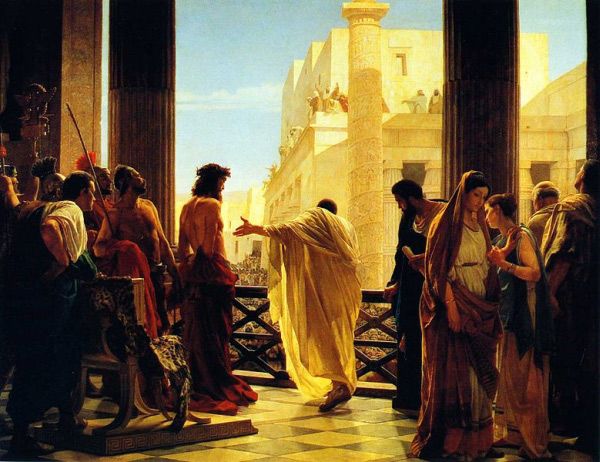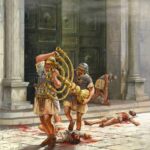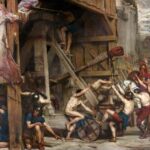Chapters
Pontius Pilate (Pontius Pilatus) lived in the 1st century CE. His name literally means “Pilate of Pontus”. So Pontius may have come from Pontus, an ancient land in Northeast Asia Minor (present-day Turkey). He could also be a Samnite by origin, because the name Pontius could come from the Pontii family, belonging to the Italian people of the Samnites (central Italy). We do not know the year of his birth or his death; we don’t know much about his life before he came to Judea, or what he did after that. It is certain that he served as the prosecutor of Judea from 26-36 / 37 CE. In keeping with the Christian Gospels and Josephus he led the trial of Jesus Christ and approved his sentence. The details of his life before his office in Judea are unknown, and after his governorship, they relate to a number of legends.
The main sources for the fate of the historical Pilate are: “Ancient history of Israel” and “The Jewish War” of Joseph Flavius, the text of Philo of Alexandria “Message to Gaius” and “New Testament”. The “Church History” by Eusebius of Caesarea and the “Annals” of Tacitus is among the smaller ones.
Assuming that Pontius came from central Italy, it can be assumed that Pontius had big problems in the development of his political career. Rome once waged heavy wars with the Samnites – therefore Pilate could not get the highest positions in the Roman administration, e.g. he could not become a senator. At that time, the Romans did not like the Samnites. Probably due to protection – a common thing in Rome – he was an equine, and then a military tribune in Germany, where he fought heavy wars with Germanic tribes. During the reign of Emperor Tiberius, he was appointed the procurator of Judea (with the powers of the governor) in 26 CE, as the successor of Valerius Gratus. He assumed the office as a protege of Sejanus (a friend of Emperor Tiberius, Prefect of the Praetorian Guard), who was a self-declared anti-Semite. Pilate also disliked the Jewish people and came into conflict with his subjects on several occasions. At the beginning of his reign, he brought banners with the image of the emperor to the Antonia fortress:
Now Pilate, who was sent as procurator into Judea by Tiberius, sent by night those images of Cæsar that are called ensigns, into Jerusalem. This excited a very among great tumult among the Jews when it was day; for those that were near them were astonished at the sight of them, as indications that their laws were trodden under foot; for those laws do not permit any sort of image to be brought into the city. Nay, besides the indignation which the citizens had themselves at this procedure, a vast number of people came running out of the country. These came zealously to Pilate to Cesarea, and besought him to carry those ensigns out of Jerusalem, and to preserve them their ancient laws inviolable; but upon Pilate’s denial of their request, they fell down prostrate upon the ground, and continued immoveable in that posture for five days, and as many nights.
On the next day Pilate sat upon his tribunal, in the open market place, and called to him the multitude, as desirous to give them an answer; and then gave a signal to the soldiers, that they should all by agreement at once encompass the Jews with their weapons; so the band of soldiers stood round about the Jews in three ranks. The Jews were under the utmost consternation at that unexpected sight: Pilate also said to them, that they should be cut in pieces, unless they would admit of Cæsar’s images, and gave intimation to the soldiers to draw their naked swords. Hereupon the Jews, as it were at one signal, fell down in vast numbers together, and exposed their necks bare, and cried out that they were sooner ready to be slain, than that their law should be transgressed. Hereupon Pilate was greatly surprised at their prodigious superstition, and gave order that the ensigns should be presently carried out of Jerusalem.
– Flavius Josephus, Jewish War, XIX.2-3
Pontius Pilate presented the scourged Jesus of Nazareth to the inhabitants of Jerusalem.
Philo of Alexandria wrote that Pilate placed some gilded shields in Herod’s palace in honour of Caesar. There was no forbidden symbol on them, only an inscription of who and for whom had displayed the shields. The Jews, however, demanded that the shields be removed. When Pilate refused, they turned to Tiberius. Only his order forced Pilate to remove the symbols. This event probably took place in 32 CE. For followers of Judaism, placing imperial symbols in their holy places was idolatry.
During his office in Caesarea Maritima (Caesarea Maritima), which was the seat of prosecutors, he erected a temple dedicated to the Emperor Tiberius. Pontius Pilate also violated the treasure of the Temple to build an aqueduct:
After this he raised another disturbance, by expending that sacred treasure which is called Corban upon aqueducts, whereby he brought water from the distance of four hundred furlongs. At this the multitude had indignation; and when Pilate was come to Jerusalem, they came about his tribunal, and made a clamour at it. Now when he was apprized aforehand of this disturbance, he mixed his own soldiers in their armour with the multitude, and ordered them to conceal themselves under the habits of private men, and not indeed to use their swords, but with their staves to beat those that made the clamour. He then gave the signal from his tribunal [to do as he had bidden them]. Now the Jews were so sadly beaten, that many of them perished by the stripes they received, and many of them perished as trodden to death by themselves; by which means the multitude was astonished at the calamity of those that were slain, and held their peace.
– Josephus Flavius , Jewish War, IX.4
During the public ministry of Jesus Christ, Pilate also massacred Galilean Jewish pilgrims who travelled to Jerusalem with victims. At the turn of 36/37 CE. Pilate killed the armed Samaritans who wanted to climb Mount Gerizim, led by the trickster and the instigator. The legate of Syria, Lucius Vitellius, ordered Pilate to depart for Rome to justify himself to the emperor for the accusations raised by the Samaritans, but by the time he came to Rome, Tiberius was already dead. Eusebius of Caesarea in his “Ecclesiastical History” reported that during the reign of the next emperor, Caligula, Pilate suffered such great misfortunes that he had to commit suicide. Eusebius referred to the Greek writers who gave an overview of the Olympics and what happened each year. Pilate also had a wife who, according to tradition, was to be called Procula.
Pilate’s Stone
In 1961, on an archaeological site of an ancient amphitheatre in Coastal Caesarea, the capital of the Province of Judea, a Latin inscription was discovered on a limestone block. There were damaged dedications of Pontius Pilate on it. The inscription was found by a group led by Antonio Frova. Its reconstruction was as follows: [Caesariens (ibu)]s Tiberiéum [Pon]tius Pilatus [praef]ectus Iuda [ea]e [d]e [dit] – “Pontius Pilate, prefect of Judea, donated Tiberieum to the people of Caesarea. ” The first line of this inscription is the subject of much debate and speculation. Although Frov’s reconstruction is widely cited, particularly in popular science, it is nevertheless disputed by many. Various other variants of the reconstruction have been proposed. E. Weber recommended: [Kal (endis) Iulii]s Tiberiéum [M (arcus)? Po]ntius Pilatus [praef]ectus Iuda [ea]e [dedicavit] – “Marcus (?) Pontius Pilate, Prefect of Judea, dedicated Tiberieum on July 1.” A. Degrassi suggested: [Dis Augusti]s Tiberiéum [Pon]tius Pilatus [praef]ectus Iuda [ea]e [fecit, d]e [dicavit] – “Pontius Pilate, prefect of Judea, built Tiberieum and dedicated them to the divine Augustoms”. Alexander Demandt proposed instead: [Incoli]s Tiberiéum [Ponti]us Pilatus [praef]ectus Iud [aeae refecit] – “Pontius Pilate, Prefect of Judea, rebuilt Tiberieum for the inhabitants”. Géza Alföld’s reconstruction was identical to Demandt’s, only he interpreted the first word as Nautis (“for the sailors”). He believed that the inscription commemorates the reconstruction of the port in Caesarea Seaside (perhaps the lighthouse in particular).
The most valuable piece of information is the third line from which we learn that Pilate’s official title was “prefect” (praefectus). Jozef Flavius and Tacitus, on the other hand, described Pilate as the prosecutor. However, this title was not carried by the governors of Judea until CE 44, when Judea became a Roman province for the second time. Earlier, in the years 6-41 CE, the governors of this province were of lower rank, because only the prefect. The Gospels, on the other hand, use the general term “steward” to describe Pilate’s function.
The word Tiberieum has yet to be explained. Some scholars speculate that it was a structure, perhaps a temple, built in honour of Tiberius.








